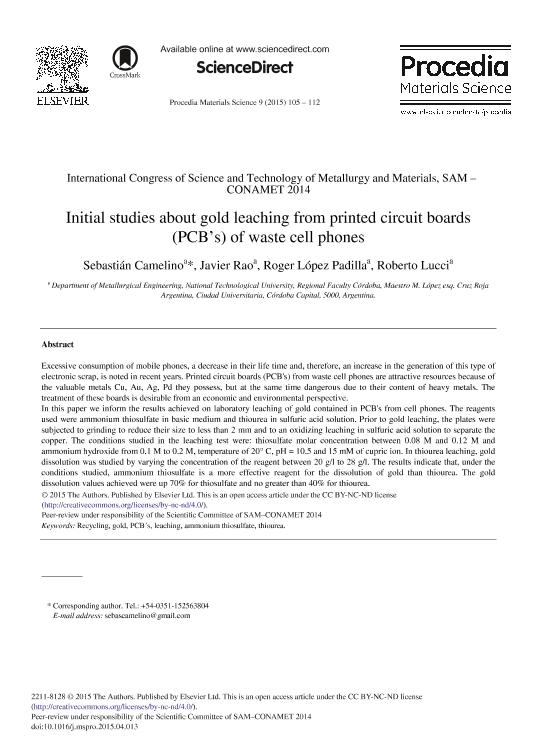Artículo
Initial Studies about Gold Leaching from Printed Circuit Boards (PCB's) of Waste Cell Phones
Fecha de publicación:
02/2015
Editorial:
Elsevier
Revista:
Procedia Materials Science
ISSN:
2211-8128
Idioma:
Inglés
Tipo de recurso:
Artículo publicado
Clasificación temática:
Resumen
Excessive consumption of mobile phones, a decrease in their life time and therefore, an increase in the generation of this type of electronic scrap, is noted in recent years. Printed circuit boards (PCB´s) from waste cell phones are attractive resources because of the valuable metals Cu, Au, Ag, Pd they possess, but at the same time dangerous due to their content of heavy metals. The treatment of these boards is desirable from an economic and environmental perspective. In this paper we inform the results achieved on laboratory leaching of gold contained in PCB´s from cell phones. The reagents used were ammonium thiosulfate in basic medium and thiourea in sulfuric acid solution. Prior to gold leaching, the plates were subjected to grinding to reduce their size to less than 2 mm and to an oxidizing leaching in sulfuric acid solution to separate the copper. The conditions studied in the leaching test were: thiosulfate molar concentration between 0.08 M and 0.12 M and ammonium hydroxide from 0.1 M to 0.2 M, temperature of 20° C, pH = 10.5 and 15 mM of cupric ion. In thiourea leaching, gold dissolution was studied by varying the concentration of the reagent between 20 g/l to 28 g/l. The results indicate that, under the conditions studied, ammonium thiosulfate is a more effective reagent for the dissolution of gold than thiourea. The gold dissolution values achieved were up 70% for thiosulfate and no greater than 40% for thiourea.
Palabras clave:
Recycling
,
Gold
,
Pcb´S
,
Leaching
Archivos asociados
Licencia
Identificadores
Colecciones
Articulos(CCT - CORDOBA)
Articulos de CTRO.CIENTIFICO TECNOL.CONICET - CORDOBA
Articulos de CTRO.CIENTIFICO TECNOL.CONICET - CORDOBA
Citación
Camelino, Sebastián Omar; Rao, Javier; López Padilla, Roger Marcio; Lucci, Roberto Oscar; Initial Studies about Gold Leaching from Printed Circuit Boards (PCB's) of Waste Cell Phones; Elsevier; Procedia Materials Science; 9; 2-2015; 105-112
Compartir
Altmétricas




